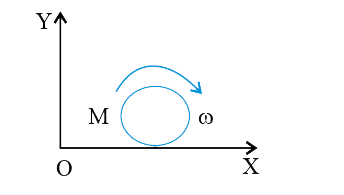Experience shows that a body irradiated with light with circular polarization acquires a torque. This happens because such a light possesses an angular momentum whose flow density in vacuum is equal to M=I/ω, where I is the intensity o flight, ω is the angualr oscillation frequacny. Suppose light with circualr polarization and wavelength λ=0.70μm falls normally on a uniform black disc of mass m=10mg which can freely rotate about its axis. How soon will its angualr velocity become equal to ω0=1.0rad/s provided I=10W/cm2?
Let r= radius of the disc
then its moment of inertia about its axis =12mr2
In time t the disc will acquire an angualr momentum
t.πr2.Iω
when circularly polarized light of intensity I falls on it. By conservation of angualr momentum this must equal
12mr2ω0
where ω0= final angualr velocity.
Equating t=mωω02πI
But ω2π=v=cλ so t=mcω0Iλ
Subsituting the values of the various quantities we get
t=11.9hours
Topper's Solved these Questions
- OPTICSBook:IE IRODOV, LA SENA & SS KROTOVChapter:OPTICSExercise:Dispersion And Absorption Of Light
Explore 24 Videos
- OPTICSBook:IE IRODOV, LA SENA & SS KROTOVChapter:OPTICSExercise:Optics Of Moving Sources
Explore 22 Videos
- OPTICSBook:IE IRODOV, LA SENA & SS KROTOVChapter:OPTICSExercise:Diffraction Of Light
Explore 60 Videos
- MECHANICSBook:IE IRODOV, LA SENA & SS KROTOVChapter:MECHANICSExercise:Mechanics Problems
Explore 92 Videos
- OSCILLATIONS AND WAVESBook:IE IRODOV, LA SENA & SS KROTOVChapter:OSCILLATIONS AND WAVESExercise:Electromagnetic Waves, Radiation
Explore 36 Videos
Similar Questions
Knowledge Check
When an unpolarised light is polarized, then the intensity of light of the polarized waves
Aremains sameBdoubledChalvedDdepends on the colour of the light.The angular momentum of a body with mass (m) moment of inertia (I) and angular velocity (ω) rad/s is equal to
AIωBIω2CIωD1ω2When an unpolarized light of intensity I0 is incident on a polarizing sheet, the intensity of the light which does not get transmitted is
AZeroBI0C12I0D14I0
A disc of mass M and radius R is rolling with angular speed w on horizontal plane as shown. The magnitude of angular momentum of the disc about the origin O is :

View SolutionWhen an unpolarized light of intensity I0 is incident on a polarizing sheet, the intensity of the light which does not get transmitted is
View SolutionWhen an unpolarized light of intensity I0 is incident on a polarizing sheet, the intensity of the light which does not get transmitted is
View SolutionWhen an unpolarized light of intensity I0 is incident on a polarizing sheet, the intensity of the light which dows not get transmitted is
View SolutionWhen an unpolarised light of inensity I0 is incident on a polarizing sheet, the intensity of the light which does not get transmittted is
View Solution

